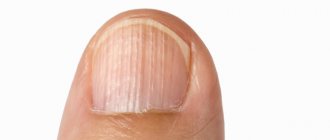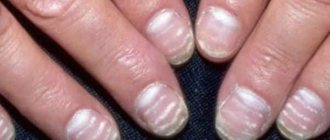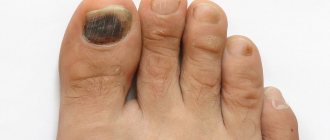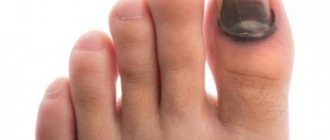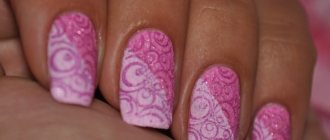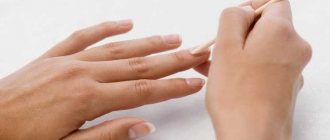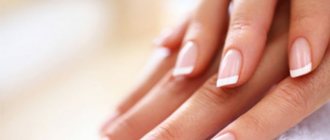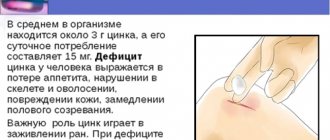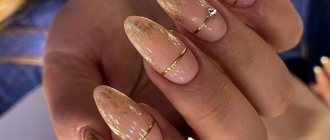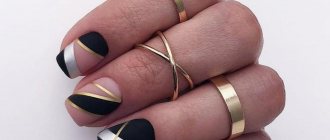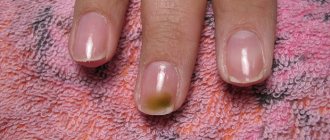What does this mean: description of the reasons for the appearance of stripes and photos
Important! Unpleasant dark stripes may appear on the nail plates. They are vertical and horizontal, differ in color, size and location. This is not just a cosmetic defect.
This most often means that there may be health problems, so if stripes occur, you should go to the doctor to find out their nature and begin treatment.
This is what the black stripes on the nails look like in the photo:
Subungual melanoma
Attention! Black streaks on the nail beds may appear due to hemorrhage associated with subungual melanoma.
This is a dangerous malignant tumor. Melanoma is a very aggressive neoplasm, so soon after its appearance, ichor begins to leak from under the nail plate, and the skin around it becomes inflamed.
If the surgeon mistakes the tumor for a panaritium and opens it, it will be fatal for the patient. Rapid metastasis will occur and the patient will have stage 4 cancer.
Digestive system dysfunction
Discoloration of the nail can be caused by ulcers, colitis, gastritis and other diseases of the digestive system. After recovery, the nails are completely renewed and the stripes disappear.
Cardiovascular diseases
In people with cardiovascular diseases, clearly visible black stripes appear on the edges of the thumbnails. Their occurrence is associated with diseases such as:
- anemia;
- pathology of the heart muscle;
- endocarditis caused by infection.
Reference. Stripes also appear when there are circulatory problems.
Mechanical damage
If the spots on the nails have a deep black, bluish or sometimes reddish tint, and do not have clearly defined boundaries, then most likely this is some kind of mechanical damage.
Depending on the severity of the injury, the stripe may be small or cover the entire plate. Very often, such stripes are found among professional athletes and fans of outdoor games that involve the hands (basketball, volleyball, tennis). As the nail plate is renewed, the stripes disappear. If the injury was very severe, the nail may fall off, but after a while a new nail plate grows in its place.
Fungus of feet and hands
The most common cause of black spots is nail fungus.
People with weak immune systems who visit public places with high humidity and high temperature are especially often infected with the fungus.
It often happens that stripes on the nails appear after a manicure done by a specialist. This means that the master did not properly process the instruments and gave you an infection. First, the disease affects the legs, since the process of sweating is most active there, and this is the most favorable environment for the propagation of the pathogen and the appearance of stripes.
Important! Hands are less likely to suffer from fungus; it usually spreads to the hands in the absence of timely or correct treatment. To solve this problem, long-term treatment will be required. Therapy can last about a year.
Diabetes
In people with high blood sugar levels, black stripes on the nails can be seen quite often. The change in color of the nail plate is caused by impaired blood flow in the vessels.
Hormones
Also, a change in nail color may be associated with taking contraceptives.
Age-related changes
Mature people often experience natural deformation of their nails. Gradually, the nail plates lose their previous shape, thicken and darken. The deformation is caused by atherosclerosis of the capillaries at the root of the plate. The flow of oxygen to the nail root is hampered. Pathological changes occur.
External exposure to chemicals
Attention! Nails are very sensitive to chemical exposure. Cleaning products and glue can affect their appearance.
Frequent use of cosmetics and nail extensions also negatively affect changes in their appearance. Spots and streaks can be caused by a lack of oxygen from prolonged use of nail polish or false nails.
What is the void under the nail on the fingers or toes: what is it called?
It often happens that under the nail peels off. This is ugly and not aesthetically pleasing, since our hands tell others about our appearance and how a woman or man takes care of themselves. What is the void under the fingernail or toenail?
- Partial detachment of the nail surface is medically called onycholysis .
- The main symptoms of the pathology: deformation or depletion of the plate due to circulatory disorders.
- It becomes more brittle, constantly crumbles and cannot develop properly.
Visually, the emptiness looks like white spots under the surface of the nail. But in reality, the pathology process develops much deeper. Small air pockets appear at the moment when particles of the plate separate from the nail bed, forming detachments inside. When identifying the initial signs of the disease, doctors advise not to delay visiting your doctor. Read more about them below.
Treatment
The most common reason for the appearance of stripes on the nail plates is illness. This means that you first need to treat the disease that caused the change in nail color. Most likely, after this the nail plates will acquire a healthy color again. To do this, you need to consult a doctor and get examined. During treatment, you can use cosmetics to hide the defect, but only if it is not caused by a fungus.
The sooner you see a doctor, the more effective the treatment will be.
If during the examination no diseases were found, then you need to visit a cosmetologist. The appearance of stripes can be caused by mechanical damage. In this case, the specialist will prescribe appropriate treatment.
Cosmetologists often recommend special procedures and medications for nail care. Most often these are special lotions, oils and moisturizers. There are also medicinal varnishes that restore the structure of the nail plate.
Reference. However, before you start using special varnishes, it is necessary to identify the cause of deformation and discoloration of the nails.
There are different types of varnishes:
- moisturizing;
- healing;
- restorative.
They contain vitamins, minerals and trace elements.
If the changes were caused by a fungus, you will be treated by a dermatologist or mycologist. In this case, self-medication is unacceptable! It will make the situation worse. Only a specialist can determine the type of spore and prescribe the correct treatment.
The doctor will recommend an antimycotic drug for external use. Most often this is an antifungal ointment or solution. In advanced cases, an oral systemic agent is prescribed.
If the changes were associated with a lack of vitamins and microelements, then the doctor will advise you to adjust your daily diet by including more fresh fruits and vegetables. Patients on diets should definitely consult a nutritionist.
Diagnosis of the formation of a void under the nail
Emptiness under the nail on the fingers
When consulting a dermatologist , the doctor conducts an initial visual examination of the finger under a lamp, in the presence of fungal infections that give a blue color. To establish an accurate determination, blood is drawn and scraped from the site of the lesion. Tests will determine the main cause of the fungus.
If a dermatologist finds it difficult to make a correct diagnosis, the patient is referred to a specialist with a narrow focus - a mycologist . If a void forms under the nail, this doctor will prescribe the following diagnosis:
- Clinical data - a person’s complaints are listened to and a set of symptoms is determined.
- Microscopic examination - scraping from the site of the lesion. If it is carried out as prescribed by a dermatologist, then the results are simply studied.
- Cultural examination - inoculation of the fungus in a special medium and identification of the pathogen by the shape of the colonies, color and growth pattern.
- DNA diagnostics - a scraping is examined to detect the DNA of a fungal infection.
In the future, complex therapy is prescribed, which includes:
- Taking antifungal drugs
- Treatment with medicinal ointments
- Strengthening the immune system, taking vitamins
- Restoration of the affected nail plate
More information about the treatment of emptiness under the nail is written below in the text. Read on.
Prevention
Complicated and sometimes unpleasant treatment will not be necessary if you follow the following preventive measures:
- Make sure that your diet is rational, balanced and organized in accordance with the characteristics of your body.
- Give up bad habits and too intense physical activity.
- Be careful and follow safety precautions when working with heavy tools.
- Take precautions when visiting the bathhouse and swimming pool, and choose your manicurist carefully.
Be carefull! Carefully monitor the condition of your nails. Perhaps this will help you identify health problems in time and get rid of them.
A void has formed under the nail - how to get rid of it: treatment on hands and feet with folk remedies
To speed up treatment and eliminate air voids in the nails, you can use traditional medicine. Since they consist entirely of natural ingredients, they are completely safe, do not cause an allergic reaction, and increase the effectiveness of the main treatment. So, how to get rid of a defect when a void has formed under the nail? Here is a treatment for hands and feet using folk remedies:
A bath that helps get rid of emptiness under the nail
BATHS:
It is important to remember that the water should not be too hot. The duration of the procedure is 20 minutes . Make a solution and dip your hands or feet into it. Then wipe with a dry towel. You can make baths with the following solutions:
- To strengthen the nail plate, use a mixture of iodine and vegetable oil . Heat the oil, add a few drops of liquid vitamin A and iodine .
- Sea salt baths can soothe flaking and reduce the layering of nails. At 500 mg . Dissolve 1 tablespoon in sea salt without dye or flavoring.
- Olive baths soften the skin, while at the same time allowing you to saturate the nail plate with microelements. Heat the oil in a water bath and mix 2 tbsp olive oil, 2 tbsp honey , add 1 egg . Dip the affected nail into the mixture. After the procedure, rinse, wipe dry, lubricate with cream.
- A decoction of celandine for nail fungus . The oil of this plant and tincture are also used.
BROTH:
- In 250 ml. water add 1 tbsp chamomile flowers and 1 tbsp. green tea Let it boil and simmer over low heat for several minutes. After the infusion has cooled to a comfortable temperature, lower the affected finger. Keep for about 20 minutes .
Strengthening nails with CALENDULA tincture:
- Treat the affected nail plate daily with an alcohol tincture solution.
LEMON:
Strengthens nails, prevents their fragility, eliminates yellowness. The medicine is done like this:
- Cut the citrus in half and leave for 10 minutes. the affected finger into the pulp.
- After the procedure, the painful area is carefully filed down.
IODINE:
- With the help of constant treatment with an alcohol solution of iodine, it is possible to cure fungal nail infections. But it must be remembered that antifungal therapy with iodine should be carried out for three weeks - no less.
- During this time, lubricate the affected nail with iodine. It's better to do this at night.
PROPOLIS:
- Moisten the diseased nail plate with propolis tincture 2 times a day for 10-14 days .
- After the course, the nail peels off and a new one grows in its place.
When using traditional medicine, you must remember that they do not replace the treatment regimen prescribed by your doctor. Alternative treatment acts as an additional assistant, relieving symptoms, but not curing them.
How to choose a nail shape for extensions
Experienced manicurists classify a number of shapes for natural plates rather as conditionally possible - “triangle”, “clear square”, “beveled shape” and “pointe shoes”. Such configurations can look ideal only on artificial nails.
Quite often, natural plates, even if they are quite strong and even, with such forms break off after a while. To avoid such troubles, you should additionally strengthen the plate with acrylic or gel before creating the shape.
Choosing the shape of your nails when adding extensions is an important part of the manicure technique. First, it is important to decide on the ideal length; it is strictly individual for each girl. In particular, those with thin, oblong fingers are not recommended to choose a very long option, as the result will look like claws. A specialist in the salon should help recommend the most optimal form.
When adding extensions, the name of the nail shapes is determined by their varieties:
- clear and soft square,
- oval,
- triangular,
- almond-shaped,
- pipe tube,
- pike,
- beveled,
- stylet,
- oval-square,
- beveled-twisted.
Nail plate shapes that are close to square are suitable for women with long fingers and men, oval - for a sophisticated hand, thin and miniature nails. Other shapes are also selected according to the type of palm, its length and even general physique. If a woman has wide, curvy arms, triangular options suit her best.
Types of grooves and their differences
Stripes on nails are distinguished according to their location and are divided into:
- longitudinal (vertical);
- transverse (horizontal).
The following types of grooves are also distinguished depending on the nature of the manifestations:
- protruding stripes;
- linear recesses;
- pigmented stripes;
- numerous dots, dents and bumps.
The differences between the main types of grooves are:
- degree of prevalence;
- nature of manifestations;
- reasons that caused the defect.
Thus, longitudinal grooves can appear as follows:
- appearance on one or several nails;
- intersection of the entire nail plate or just a part;
- occurring parallel to the edges of the nail or along its central part.
The main reasons for the occurrence of longitudinal stripes are:
- diseases;
- deviations in the functioning of the body;
- physical damage to the nail.
Transverse grooves are much less common and most often occur for the following reasons:
- digestive system imbalance;
- physical damage;
- zinc deficiency;
- consequences of certain diseases;
- old age (an indicator of natural aging of the body).
What types of nails are there: names
Nail shapes for natural plates are not as diverse as for extended ones. However, the groups that unite them have their own variations.
"Clear square"
One of the most popular nail shapes. Perfectly executed, it consists of two parallel side lines of the nail plate and an even perpendicular cut from above. Sharp right angles at the top of the nail are a characteristic feature of the shape. “Clear Square” looks best on nails with medium length. Such plates are suitable for owners of long, thin fingers with an elongated nail bed.
Conversely, the square is contraindicated for girls with short, dense fingers and a wide nail plate. Since such a shape will make them even larger, and the manicure will look ridiculous.
Unfortunately, the Clear Square is a very unstable form. On natural nails there is a high risk of corners breaking off, which will look unsightly. And if the nails themselves are also thin, then as they grow, the entire square effect will be lost, since the free tip will begin to fall to the side or turn inward.
"Soft Square"
This shape is more stable, since it is a square at the base, but with smoothed corners. It will look great with either short or medium length. The “Soft Square” will suit almost any hand shape. The only exception is for girls with overly wide nail plates.
This form is often chosen as a compromise solution for those with problem nails. This option is not so susceptible to deformation when the free end grows, and flaws in the manicure are not so noticeable here.
"Oval"
“Oval” is a universal shape, suitable for any configuration of plates and features of the hand. Manicurists consider this form to be basic. Its characteristic feature is that the free edge completely follows the shape of the nail bed and the line of the hole - the base of the nail.
"Square oval"
This is another compromise for girls who, due to the characteristics of their nail plates, cannot afford a square shape.
“Square oval” is an intermediate option between square and oval.
A characteristic feature is a square base, sharp corners at the edges, but with an arched free tip. This shape can be done even by girls with wide plates, since due to the ovality, the shape of the tip will distract attention from the wide plates and help visually lengthen the fingers.
Round form
The round shape is done only on short nails; on long plates it looks ridiculous. In fact, this form is original, natural, i.e. if the nail plate has not grown enough to give it any shape, then the round option is perfect here.
To create it, 1 mm of free tip will be enough. In execution, it simply follows the curve of the edge of the finger. However, it requires significant and timely adjustment during regrowth due to the changing direction of plate growth.
Almond shape
The almond shape is suitable only for those with narrow plates and graceful long fingers. From the hole itself, the nail smoothly moves towards the center and curves at the tip. A characteristic feature of this form is the absence of any corners.
The length of the nail bed should not be long, since the free tip of the almond-shaped nails should always be longer. And if you end up with an excessively long “tonsil,” it will look unnatural and bend to the sides.
Triangular shape or "cat's claw"
The triangular shape or so-called “cat claws” are suitable only for girls with narrow plates on thin fingers. On large or wide nails it will look a little scary, reminiscent of a witch's nails.
The characteristic feature is similar to the almond shape - the same smooth bend towards the center, but an acute angle is formed at the end. This form is extremely inconvenient due to the high risk of breaking off the free end. Therefore, girls with fairly strong nail plates can afford the triangular option.
"Pointe shoes", "ballerina", "coffin"
“Pointe shoes”, “ballerina”, “coffin” - three names for the same nail shape, which has been extremely popular in recent seasons. This favorite shape fits almost any configuration of brushes and nail plates. It is only important to comply with the only condition - for girls with wide plates, the free edge should be of medium length, the rest can be left in both short and medium size.
The “Pointe” shape is a kind of mix between a triangular and square shape. It is based on a triangular shape - the edges of the nail plates tend to the center, but the free tip has a perpendicular cut with sharp corners, thus forming a trapezoid at the tip.
Like a square, this shape is quite fragile and there is a high risk of damaging the corners. And on overgrown thin nails, the tip may even curl into a cone, the shape will simply be lost.
Beveled shape
This option is a variation of the square plate. On the sides it is formed by the same straight lines, but the tip is not cut perpendicularly, but has a straight oblique cut, forming two angles - obtuse and acute. The cut can be made either in the same way on all fingers or in different directions.
Curved, deformed nails will look ridiculous.
The beveled shape looks best on nails with long narrow plates. The optimal length is medium. But even for this form, a condition must be met - a strong nail plate.
